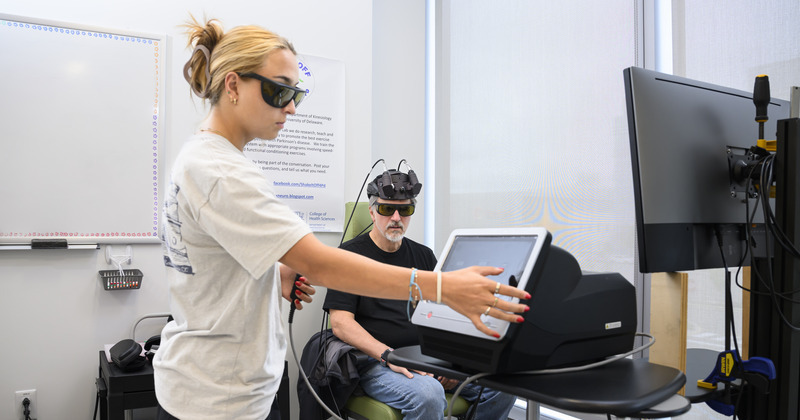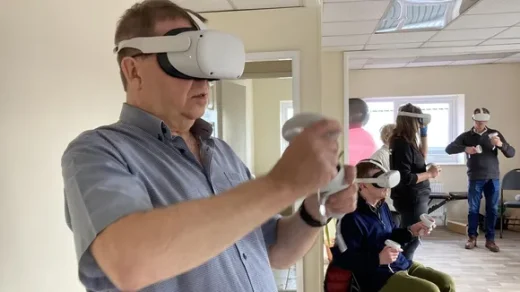
Photos by Kathy F. Atkinson July 10, 2025
Tim Hihn, 64, first noticed a significant twitch in his right arm several years ago. He was diagnosed with Parkinson’s disease (PD) in 2021. Since then, the semi-retired sixth-generation mushroom farmer from West Grove, Pennsylvania, has also noticed cognitive changes.
“I used to multitask easily. Now, I have to focus on one task at a time,” Hihn said.
Seeking help, Hihn joined a research study at the University of Delaware College of Health Sciences. Several times a week, he wears a helmet equipped with sensors designed to stimulate the brain with laser therapy.
“It feels like the warmth of the sun on your head,” he said.
The study is blinded, so participants don’t know whether they’re receiving laser therapy or a placebo. Still, after 18 sessions over six weeks, Hihn believes he’s noticed changes.
“Things I used to be good at, like math, memory and organization, I’m better at now,” he said.
The science behind the intervention
Infrared laser technology has been used for decades to treat tendon and muscle injuries.
“Pitchers in the MLB use it before games to increase metabolism in their arm, which seems to have an injury prevention effect,” said John Jeka, professor of kinesiology and applied physiology (KAAP). “Now, we’re exploring how the same technology can benefit the brain.”
In Newark, Brian Pryor, co-founder and CEO of NeuroThera, is studying photobiomodulation as a treatment for major depressive disorder and traumatic brain injury, where it has shown significant promise, as well as for Alzheimer’s and PD.
“Everyone knows somebody affected by these diseases, and they’re desperate for better outcomes,” Pryor said. “Laser therapy has enormous potential.”
Pryor is collaborating with Jeka and co-investigators Thomas Buckley and Roxana Burciu, both KAAP faculty, to study the effects of laser therapy on PD.
The goal is to improve symptoms by targeting brain regions affected by Parkinson’s, such as the frontal cortex, which supports executive function and memory and helps control motor behavior.
“Multiple studies have shown that laser therapy can penetrate brain tissue, improving cellular metabolism and increasing blood flow,” Burciu said. “We hope this leads to improvements in mobility, balance and executive function.”
Their study is unique because it includes a placebo group, which helps determine whether the observed effects are due to the therapy itself rather than expectations or unrelated factors. Participants are also tested off medication, as medication can mask or confound treatment-related changes.
“We want to understand the effects of the treatment on the disease without the influence of medication,” Jeka said.


